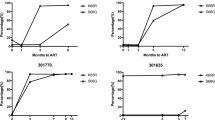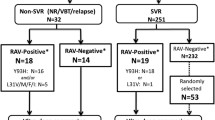Abstract
Human Immunodeficiency Virus Type 1 exists in vivo as quasispecies, and one of the genome’s characteristics is its diversity. During the antiretroviral therapy, drug resistance is the main obstacle to effective viral prevention. Understanding the molecular evolution process is fundamental to analyze the mechanism of drug resistance and develop a strategy to minimize resistance.
Objective
The molecular evolution of drug resistance of one patient who had received reverse transcriptase inhibitors for a long time and had treatment which replaced Nevirapine with Indinavir was analyzed, with the aim of observing the drug resistance evolution pathway.
Methods
The patient, XLF, was followed-up for six successive times. The viral populations were amplified and sequenced by single-genome amplification. All the sequences were submitted to the Stanford HIV Drug Resistance Database for the analysis of genotypic drug resistance.
Results
149 entire protease and 171 entire reverse transcriptase sequences were obtained from these samples, and all sequences were identified as subtype B. Before the patient received Indinavir, the viral population only had some polymorphisms in the protease sequences. After the patient began Indinavir treatment, the variants carrying polymorphisms declined while variants carrying the secondary mutation G73S gained the advantage. As therapy was prolonged, G73S was combined with M46I/L90M to form a resistance pattern M46I/G73S/L90M, which then became the dominant population. 97.9% of variants had the M46I/G73S/L90M pattern at XLF6. During the emergence of protease inhibitors resistance, reverse transcriptase inhibitors resistance maintained high levels.
Conclusion
Indinavir-resistance evolution was observed by single-genome amplification. During the course of changing the regimen to incorporate Indinavir, the G73S mutation occurred and was combined with M46I/L90M.
Similar content being viewed by others
References
Alexander D C. 1990. A rapid method for determining clone frequency in complex populations using PCR and the Poisson distribution. Nucl Acids Res, 18(24): 7453–7454.
Bélec L, Piketty C, Si-Mohamed A, et al. 2000. High levels of drug-resistant Human Immunodeficiency Virus variants in patients exhibiting increasing CD4+ T cell counts despite virologic failure of protease inhibitor-containing antiretroviral combination therapy. J Infect Dis, 181(5): 1808–1812.
Chen Z, Li Y, Schock H B, et al. 1995. Three-dimensional structure of a mutant HIV-1 protease displaying cross-resistance to all protease inhibitors in clinical trials. J Biol Chem, 270(37): 21433–21436.
Clavel F, Hance A J. 2004. HIV drug resistance. N Engl J Med, 350(10): 1023–1035.
Coffin J M. 1995. HIV population dynamics in vivo: implications for genetic variation, pathogenesis, and therapy. Science, 267: 483–489.
Condra J H, Holder D J, Schleif W A, et al. 1996. Genetic correlates of in vivo viral resistance to Indinavir, a Human Immunodeficiency Virus type 1 protease inhibitor. J Virol, 70(12): 8270–8276.
Descamps D, Joly V, Flandre P, et al. 2005. Genotypic resistance analyses in nucleoside-pretreated patients failing an indinavir containing regimen: results from a randomized comparative trial: (Novavir ANRS 073). J Clin Virol, 33: 99–103.
Dybul M, Daucher M, Jensen M A, et al. 2003. Genetic characterization of rebounding Human Immunodeficiency Virus type 1 in plasma during multiple interruptions of highly active antiretroviral therapy. J Virol, 77(5): 3229–3237.
Gunthard H F, Wong J K, Ignacio C C, et al. 1998. Comparative performance of high-density oligonucleotide sequencing and dideoxynucleotide sequencing of HIV type 1 pol from clinical samples. AIDS Res Hum Retroviruses, 14: 869–876.
Kaplan A H, Michael S F, Wehbie R S, et al. 1994. Selection of multiple Human Immunodeficiency Virus type 1 variants that encode viral proteases with decreased sensitivity to an inhibitor of the viral protease. Proc. Natd. Acad. Sci, 91: 5597–5601.
Kinai E, Hanabusa H, Kato S. 2007. Prediction of the efficacy of antiviral therapy for Hepatitis C Virus infection by an ultrasensitive RT-PCR assay. J Med Virol, 79: 1113–1119.
Kondo M, Sudo K, Tanaka R, et al. 2009. Quantitation of HIV-1 group M proviral DNA using TaqMan MGB real-time PCR. J Virol Methods, 157: 141–146.
Mansky L M, Temin H M. 1995. Lower in vivo mutation rate of human immunodeficiency virus type 1 than that predicted from the fidelity of purified reverse transcriptase. J Virol, 69: 5087–5094.
Palmer S, Kearney M, Maldarelli F, et al. 2005. Multiple, linked Human Immunodeficiency Virus type 1 drug resistance mutations in treatment-experienced patients are missed by standard genotype analysis. J Clin Microbiol, 43(1): 406–413.
Perelson A S, Neumann A U, Markowitz M, et al. 1996. HIV-1 dynamics in vivo: viron clearance rate, infected cell life-span, and viral generation time. Science, 271(5255): 1582–1586.
Preston B D, Poiesz B J, Loeb L A. 1988. Fidelity of HIV-1 reverse transcriptase. Science, 242: 1168–1171.
Rhee S Y, Taylor J, Wadhera G, et al. 2006. Genotypic predictors of human immunodeficiency virus type 1 drug resistance. Proc Natl Acad Sci USA, 103: 17355–17360.
Ridky T W, Kikonyogo A, Leis J, et al. 1998. Drugresistant HIV-1 proteases identify enzyme residues important for substrate selection and catalytic rate. Biochemistry, 37(39): 11835–11845.
Roberts J D, Bebenek K, Kunkel T A. 1988. The accuracy of reverse transcriptase from HIV-1. Science, 242: 1171–1173.
Rousseau C M, Birditt B A, McKay A R, et al. 2006. Large-scale amplification, cloning and sequencing of near full-length HIV-1 subtype C genomes. J Virol Methods, 136: 118–125.
Saah A J, Haas D W, DiNubile, et al. 2003. Treatment with Indinavir, Efavirenz, and Adefovir after failure of Nelfinavir therapy. J Infect Dis, 187(7): 1157–1162.
Salazar-Gonzalez J F, Bailes E, Pham K T, et al. 2008. Deciphering Human Immunodeficiency Virus type 1 transmission and early envelope diversification by single genome amplification and sequencing. J Virol, 82(8): 3952–3970.
Schuurman R, Brambilla D, Groot T D, et al. 2002. Underestimation of HIV type 1 drug resistance mutations: results from the ENVA-2 genotyping proficiency program. AIDS Res Hum Retroviruses, 18:243–248.
Simmonds P, Balfe P, Peutherer J F, et al. 1990. Human Immunodeficiency Virus-infected individuals contain provirus in small numbers of peripheral mononuclear cells and at low copy numbers. J Virol, 64(2): 864–872.
Sykes P J, Neoh S H, Brisco M J, et al. 1992. Quantitation of targets for PCR by use of limiting dilution. Biotechniques, 13(3): 444–449.
Yap S H, Sheen C W, Fahey J, et al. 2007. N348I in the connection domain of HIV-1 reverse transcriptase confers Zidovudine and Nevirapine resistance. Plos Med, 4(12): 1887–1899.
Author information
Authors and Affiliations
Corresponding author
Additional information
Foundation items: National Natural Science Foundation of China (30830088 and 30800938); The National Key and Special Projects on Major Infectious Disease Grant (2008 ZX10001-004)
Rights and permissions
About this article
Cite this article
Geng, Qm., Li, Hp., Bao, Zy. et al. Indinavir resistance evolution in one human immunodeficiency virus type 1 infected patient revealed by single-genome amplification. Virol. Sin. 25, 316–328 (2010). https://doi.org/10.1007/s12250-010-3122-4
Received:
Accepted:
Published:
Issue Date:
DOI: https://doi.org/10.1007/s12250-010-3122-4




